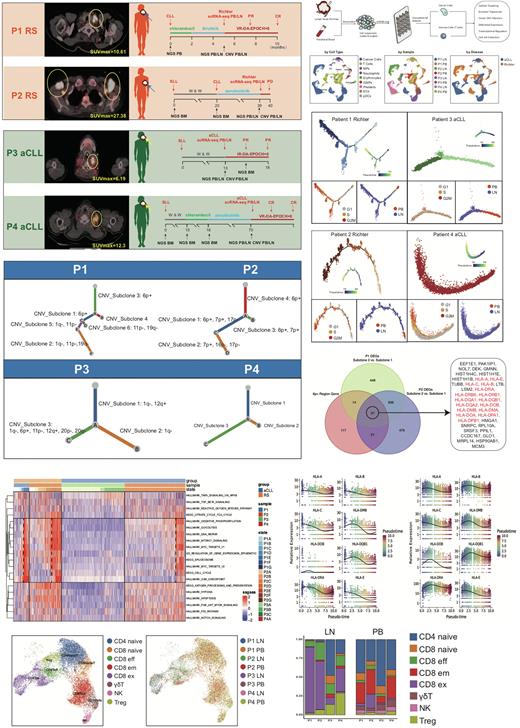Abstract
Introduction Richter transformation (RT) and "accelerated” CLL (aCLL) were both regarded as the aggressive manifestation of CLL. The underlying mechanisms of such aggressive transformation has not been fully disclosed yet, especially transformed after novel targeted agents like BTK inhibitors. Moreover, cases reported that aCLL was observed with subsequent transformation of diffuse large B cell lymphoma (DLBCL) and aCLL may represent an early stage of transformation. However, such clinical observations lack biological evidence to compare the similarities and differences between aCLL and RT.
Methods Single-cell RNA sequencing (scRNA-seq) of paired lymph node (LN) and peripheral blood (PB) was performed among 2 RT (P1, P2) and 2 aCLL (P3, P4) patients (pathologically diagnosed in LN) and bioinformatics analysis was conducted. Patient 1 and Patient 2 were initially treated with BTK inhibitors (P1 ibrutinib for 3 months and P2 zanubrutinib for 19 months) and then progressed to RT. Patient 3 was initially diagnosed as aCLL and Patient 4 was treated with zanubrutinib for 54 months and then progressed to aCLL.
Results Identification of cell types in 4 patients showed great heterogeneity. Higher proportion of proliferative tumor with cells at either the G2/M or S phase was found in two RT patients than in two aCLL patients. Single-cell trajectory construction was done using "monocle 2” inferred tumor development and differentiation among each patient. Tumor cells from PB were distributed in the front of trajectories, indicating that the progressive LNs were evolved from PB indolent CLL cells. Moreover, among three patients progressing from BTK inhibitors (BTKi), highly proliferative tumor cells were enriched in the end of trajectories, indicating their resistant characteristics to BTKi. Single-cell GSEA (ssGSEA) analysis showed that pathways of spliceosome, MYC targets, mTORC1, epigenetics, DNA repair, glycolysis and oxidative phosphorylation were significantly activated in those proliferative tumor cells enriched in the end of trajectories while remained inactivation in treatment-naïve tumor cells, comprehensively leading to resistance to BTKi treatment. Although zanubrutinib-resistant aCLL of P4 showed relatively lower proportion of highly proliferative tumor cells than RT patients, they shared common biological characters and could be regarded as the early phase of RT.
InferCNV analysis was performed and UPhyloplot2 was used to construct the copy number gain and loss evolution. Notably, 6p copy number gain has lost in the end of CNV tree which was enriched in highly proliferative tumor cells of RT while such phenomenon has not been found in two aCLL patients. The involved genes in this 6p CNV region were screened and we found significant enrichment of MHC Class I and Class II genes. The expression of such MHC Class I and Class II genes were also showed gradual downregulation in thoese highly proliferative tumor cells in RT, indicating their escape from immune surveillance. Moreover, exhaustion T cells also showed significantly higher proportion in LNs of RT than LNs of aCLL, indicating the exhausted immune environment of RS.
Conclusion scRNA-seq analysis showed that highly proliferative tumor cells in BTKi-resistant progression to RT and aCLL showed common cell cycle, glycolysis, oxidative phosphorylation, spliceosome, epigenetics and MYC targeted activation. BTKi-resistant progression to aCLL could be regarded as an early phase of RT. Moreover, RT exhibited more exhausted immune microenvironment and significant downregulation of antigen presentation, indicating that combination of immune checkpoint inhibitors might be of clinical significance in RT treatment.
Disclosures
No relevant conflicts of interest to declare.
Author notes
Asterisk with author names denotes non-ASH members.


This feature is available to Subscribers Only
Sign In or Create an Account Close Modal